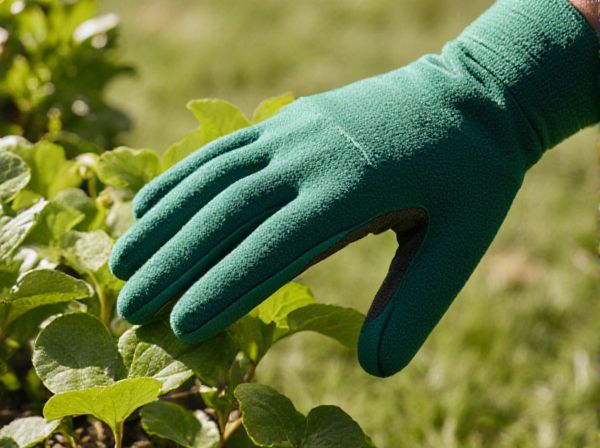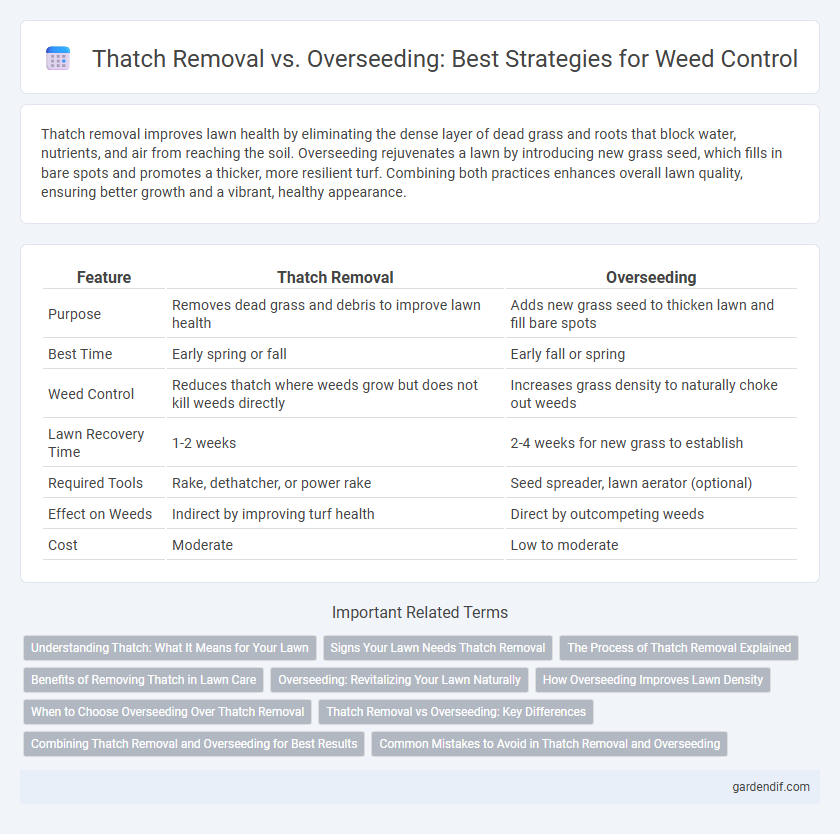
Thatch removal vs overseeding Illustration
Thatch removal improves lawn health by eliminating the dense layer of dead grass and roots that block water, nutrients, and air from reaching the soil. Overseeding rejuvenates a lawn by introducing new grass seed, which fills in bare spots and promotes a thicker, more resilient turf. Combining both practices enhances overall lawn quality, ensuring better growth and a vibrant, healthy appearance.
Table of Comparison
| Feature | Thatch Removal | Overseeding |
|---|---|---|
| Purpose | Removes dead grass and debris to improve lawn health | Adds new grass seed to thicken lawn and fill bare spots |
| Best Time | Early spring or fall | Early fall or spring |
| Weed Control | Reduces thatch where weeds grow but does not kill weeds directly | Increases grass density to naturally choke out weeds |
| Lawn Recovery Time | 1-2 weeks | 2-4 weeks for new grass to establish |
| Required Tools | Rake, dethatcher, or power rake | Seed spreader, lawn aerator (optional) |
| Effect on Weeds | Indirect by improving turf health | Direct by outcompeting weeds |
| Cost | Moderate | Low to moderate |
Understanding Thatch: What It Means for Your Lawn
Thatch is a dense layer of dead grass, roots, and organic matter that accumulates between the soil and the green turf, impacting lawn health by restricting water, nutrients, and air flow. Removing thatch, typically through dethatching or core aeration, improves soil penetration and promotes stronger grass roots. Overseeding complements thatch removal by introducing new grass varieties that enhance lawn density and resilience against weeds and environmental stress.
Signs Your Lawn Needs Thatch Removal
Yellowing grass, spongy soil, and poor water absorption are clear indicators your lawn requires thatch removal. Excessive thatch buildup prevents nutrients and air from reaching grassroots, leading to weakened turf and increased weed growth. Removing thatch enhances lawn health and prepares the soil for successful overseeding.
The Process of Thatch Removal Explained
Thatch removal involves using specialized rakes or power dethatchers to lift and extract the dense layer of dead grass, roots, and organic debris that accumulates between the soil and green turf. This process improves air, water, and nutrient penetration, enhancing lawn health and reducing weed proliferation. Performing dethatching during the lawn's active growing season allows for quick recovery and promotes a stronger, more weed-resistant turf.
Benefits of Removing Thatch in Lawn Care
Removing thatch in lawn care enhances water absorption and nutrient penetration by eliminating the dense layer of dead grass and roots that block soil access. This process reduces the risk of weed infestation and disease by improving air circulation at the soil level. Regular dethatching promotes healthier, thicker grass growth, leading to a more resilient and visually appealing lawn.
Overseeding: Revitalizing Your Lawn Naturally
Overseeding is a natural method to revitalize your lawn by introducing new grass seed that improves density and fills in bare spots, effectively crowding out weeds. This process enhances the lawn's overall health by increasing turfgrass diversity and resilience, reducing the need for chemical weed control. Regular overseeding promotes a lush, green lawn that naturally suppresses weed growth through stronger competition.
How Overseeding Improves Lawn Density
Overseeding introduces new grass varieties that fill bare spots, enhancing lawn density and outcompeting weed growth. This process improves turf resilience by promoting thicker root systems and increasing overall grass coverage. Enhancing lawn density through overseeding reduces weed invasion by limiting available space and resources for unwanted plants.
When to Choose Overseeding Over Thatch Removal
Overseeding is the preferred choice over thatch removal during early fall when grass growth slows and soil temperatures drop, promoting seed germination without stressing existing turf. Choose overseeding instead of thatch removal if your lawn has thin or bare patches needing rejuvenation rather than compacted thatch buildup exceeding 0.5 inches. Opt for overseeding when the primary goal is enhancing lawn density and resilience to weeds, pests, and drought rather than addressing excessive organic layer accumulation.
Thatch Removal vs Overseeding: Key Differences
Thatch removal targets the dense layer of dead grass and roots that suffocates soil, improving water, nutrient, and air penetration to promote healthier turf growth. Overseeding introduces new grass seed directly onto existing lawns to increase density, repair bare spots, and enhance overall lawn resilience against weeds and environmental stress. Understanding the key differences reveals that thatch removal revitalizes soil conditions, while overseeding focuses on rejuvenating and thickening the grass stand.
Combining Thatch Removal and Overseeding for Best Results
Combining thatch removal with overseeding effectively improves lawn health by clearing away the dense layer of dead organic matter that prevents water and nutrients from reaching soil. This process enhances seed-to-soil contact, promoting faster germination and stronger grass establishment. Optimal timing during early fall or spring ensures weeds are minimized while new grass thrives, resulting in a thicker, more resilient lawn.
Common Mistakes to Avoid in Thatch Removal and Overseeding
Thatch removal errors often include scalping the lawn too aggressively, which damages grassroots and reduces turf density, while overseeding mistakes typically involve using poor-quality seed or failing to prepare the soil properly, leading to uneven germination and weak lawn establishment. Avoid removing thatch during wet conditions, as it compacts the soil and hinders seed penetration during overseeding. Ensuring appropriate timing, tool selection, and soil preparation improves lawn health and promotes effective weed suppression.
Thatch removal vs overseeding Infographic

 gardendif.com
gardendif.com